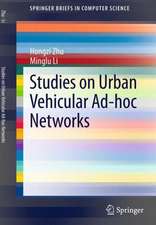Ergonomics and Safety of Intelligent Driver Interfaces
Editat de Y. Ian Noyen Limba Engleză Paperback – 1997
The role of human factors is widely acknowledged to be critical to the successful implementation of such technologies. However, too little research is directed toward advancing the science of human-ITS interaction, and too little is published which is useful to system designers. This book is an attempt to fill this critical gap. It focuses on the intelligent driver interface (IDI) because the ergonomics of IDI design will influence safety and usability perhaps more than the technologies which underlie it.
The chapters cover a broad range of topics, from cognitive considerations in the design of navigation and route guidance, to issues associated with collision warning systems, to monitoring driver fatigue. The chapters also differ in intent -- some provide design recommendations while others describe research findings or new approaches for IDI research and development. Based in part on papers presented at a symposium on the ergonomics of in-vehicle human systems held under the auspices of the 12th Congress of the International Ergonomics Association, the book provides an international perspective on related topics through inclusion of important contributions from Europe, North America, and Japan.
Many of the chapters discuss issues associated with navigation and route guidance because such systems are the most salient and arguably the most complex examples of IDI. However, the findings and research methodologies are relevant to other systems as well, making this book of interest to a wide audience of researchers, design engineers, transportation authorities, and academicians involved with the development or implementation of ITS.
Preț: 578.10 lei
Preț vechi: 680.12 lei
-15% Nou
Puncte Express: 867
Preț estimativ în valută:
110.63€ • 114.14$ • 93.63£
110.63€ • 114.14$ • 93.63£
Carte tipărită la comandă
Livrare economică 05-19 martie
Preluare comenzi: 021 569.72.76
Specificații
ISBN-13: 9780805819564
ISBN-10: 0805819568
Pagini: 448
Dimensiuni: 152 x 229 x 35 mm
Greutate: 0.73 kg
Ediția:New.
Editura: CRC Press
Colecția CRC Press
ISBN-10: 0805819568
Pagini: 448
Dimensiuni: 152 x 229 x 35 mm
Greutate: 0.73 kg
Ediția:New.
Editura: CRC Press
Colecția CRC Press
Public țintă
Professional Practice & DevelopmentCuprins
Contents: B.H. Kantowitz, R.J. Hanowski, S.C. Kantowitz, Driver Reliability Demands for Traffic Advisory Information. M.A. Mollenhauer, M.C. Hulse, T.A. Dingus, S.K. Jahns, C. Carney, Design Decision Aids and Human Factors Guidelines for ATIS Displays. J.D. Lee, A Functional Description of ATIS/CVO Systems to Guide and Accommodate Driver Needs and Limits. M. Akamatsu, M. Yoshioka, N. Imacho, T. Daimon, H. Kawashima, Driving With a Car Navigation System in an Urban Area -- Analysis of Landmarks by the Thinking Aloud Method. R. Srinivasan, P.P. Jovanis, Effect of In-Vehicle Route Guidance Systems on Driver Workload and Choice of Vehicle Speed: Findings from a Driving Simulator Experiment. G.E. Burnett, S.M. Joyner, An Assessment of Moving-Map and Symbol-Based Route Guidance Systems. T. Ross, G. Vaughan, C. Nicolle, Design Guidelines for Route Guidance Systems: Development Process and an Empirical Example for Timing of Guidance Instructions. K. Kimura, K. Marunaka, S. Sugiura, Human Factors Considerations for Automotive Navigation Systems -- Legibility Comprehension and Voice Guidance. G. Labiale, Cognitive Ergonomics and "Intelligent" Systems in the Automobile. R. Graham, V.A. Mitchell, An Evaluation of the Ability of Drivers to Assimilate and Retain In-Vehicle Traffic Messages. S. Hirst, R. Graham, The Format and Presentation of Collision Warnings. W. Janssen, H. Thomas, In-Vehicle Collision Avoidance Support Under Adverse Conditions. H. Alm, O. Svidén, Y. Wærn, On Cognitive Integration of IVHS Functions Around the Driver's Task. L.L.M. Bossi, N.J. Ward, A.M. Parkes, P.A. Howarth, The Effect of Vision Enhancement Systems on Driver Peripheral Visual Performance. L. Stapelton, Perceptual Attention to Contact Analogue Head Up Displays. T. Daimon, H. Kawashima, M. Akamatsu, Drivers' Cognitive Process and Route Guidance. D.M. Zaidel, Y.I. Noy, Automatic vs. Interactive Vehicle Navigation Aids. J.R. Buck, J.R. Bloomfield, A. Yenamendra, Ergonomic Issues on Entering the Automated Highway System. J.H. Richardson, S.H. Fairclough, S. Fletcher, J. Scholfield, Driver Fatigue: An Experimental Investigation. K. Wochinger, D. Boehm-Davis, Navigation Preference and Driver Acceptance of Advanced Traveler Information Systems. S.H. Fairclough, Monitoring Driver Fatigue via Driving Performance. S.A. Moss, T.J. Triggs, Attention Switching Time: A Comparison Between Young and Experienced Drivers. A. Parkes, The Role of Standards in In-Vehicle MMI.
Descriere
The role of human factors is widely acknowledged to be critical to the successful implementation of such technologies. However, too little research is directed toward advancing the science of human-ITS interaction, and too little is published which is useful to system designers. This book is an attempt to fill this critical gap.












